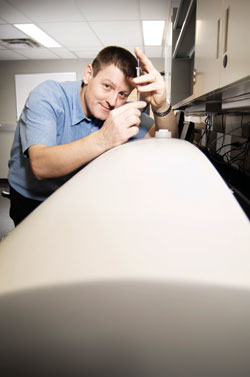Laszlo Kalman has CFI support to unlock potential of photosynthesis

Laszlo Kalman’s work combines biology, physics and chemistry to identify new potential sources of energy.
Christian Fleury
On the surface, it’s a relatively simple process, but as Laszlo Kalman explains, we still have a long way to go in understanding the underlying mechanisms that make it work.
Kalman, a self-described “misfit,” is cross-appointed between the Departments of Physics and Chemistry & Biochemistry, with an affiliated position in Biology. “Really,” he said, “I’m a biophysicist.”
He and his research group take an interdisciplinary approach to their work with a specific focus on “the coupling between light-induced electron and proton transfer reactions in photosynthetic membrane proteins.” In other words, they are trying to figure out how energy conversion occurs at an atomic level in plants and bacteria.
To do so, they are looking very closely at reaction centers — combinations of pigment and protein that are specialized in the transfer of electrons — in purple bacteria. “We grow the bacteria, harvest it, then purify the reaction centre protein from it,” Kalman explained. “We can modify its environment or its genetics to see what kind of impact these changes have on the photosynthetic machinery.”
Kalman recently received a CFI grant to support his research. The funds have been used to purchase a dual polarization interferometer (DPI), which arrived just before the holiday break. It is one of only 30 such machines in the world, and only the second in Canada. (The other is located at Brock University.) “Ours is unique because of the customization required for our work in photosynthesis,” he said.
The DPI is capable of recording and monitoring structural changes in real-time at atomic resolutions. “Actually, it will show us changes as long as they occur slower than 100 milliseconds per data point, and have a resolution of one angstrom, about the length of a chemical bond.”
Kalman believes that understanding the extremely efficient energy conversion of photosynthesis is fundamental to the development of massive scale, man-made energy converting processes.
“People talk about hydrogen as the cleanest from of energy,” he said, but “clean” hydrogen is usually produced by electrolysis, the splitting of water molecules into their constituent hydrogen and oxygen molecules using electric current. Unfortunately, electrolysis requires huge amounts of energy, usually generated by fossil fuels, and so carbon is released into the atmosphere anyway.
Water is also broken into its constituent parts in photosynthesis, Kalman explained, but in a vastly more efficient manner. “If one can understand how the process works in nature, we could have a virtually unlimited source of clean energy. That’s the long-term potential of our work.”